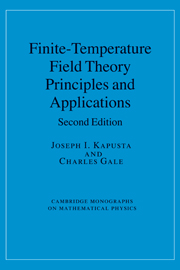Book contents
- Frontmatter
- Contents
- Preface
- 1 Review of quantum statistical mechanics
- 2 Functional integral representation of the partition function
- 3 Interactions and diagrammatic techniques
- 4 Renormalization
- 5 Quantum electrodynamics
- 6 Linear response theory
- 7 Spontaneous symmetry breaking and restoration
- 8 Quantum chromodynamics
- 9 Resummation and hard thermal loops
- 10 Lattice gauge theory
- 11 Dense nuclear matter
- 12 Hot hadronic matter
- 13 Nucleation theory
- 14 Heavy ion collisions
- 15 Weak interactions
- 16 Astrophysics and cosmology
- Conclusion
- Appendix
- Index
14 - Heavy ion collisions
Published online by Cambridge University Press: 04 November 2009
- Frontmatter
- Contents
- Preface
- 1 Review of quantum statistical mechanics
- 2 Functional integral representation of the partition function
- 3 Interactions and diagrammatic techniques
- 4 Renormalization
- 5 Quantum electrodynamics
- 6 Linear response theory
- 7 Spontaneous symmetry breaking and restoration
- 8 Quantum chromodynamics
- 9 Resummation and hard thermal loops
- 10 Lattice gauge theory
- 11 Dense nuclear matter
- 12 Hot hadronic matter
- 13 Nucleation theory
- 14 Heavy ion collisions
- 15 Weak interactions
- 16 Astrophysics and cosmology
- Conclusion
- Appendix
- Index
Summary
The only practical way of creating and studying hot and dense strongly interacting matter in the laboratory is by colliding heavy nuclei at high energies. Some of the pioneering studies have used nuclear emulsion data of highly energetic cosmic ray events. However, a serious handicap there is the lack of control over the physical beam characteristics. For a few decades now, there has existed a vibrant experimental program seeking to explore the physics of nuclear collisions in different energy regimes and with different combinations of beam and target nuclei. The pioneering experiments at the Lawrence Berkeley National Laboratory (Berkeley, USA) have been followed by several other experimental ventures. It is impossible to enumerate all the facilities, but some important efforts at the high end of the energy spectrum have been pursued at the GSI (Darmstadt, Germany), CERN (Geneva, Switzerland), and at Brookhaven National Laboratory (Upton, USA). The Relativistic Heavy Ion Collider (RHIC) is located at BNL, and the Large Hadron Collider (LHC) has a heavy ion program expected to begin at CERN around 2007. A healthy experimental program in high energy nuclear collisions requires a basis in nucleon–nucleon and nucleon–nucleus collisions. These in fact constitute a crucial category of control experiments for the more complex nucleus–nucleus events. The study of strongly interacting matter at high temperature and density enjoys an active and fruitful collaboration between the experimental and theoretical communities.
In relativistic nuclear collisions, multiple scatterings involving both the primary constituents (the original nucleons) and the secondary particles (mostly created pions) can, in principle, drive the system towards a state of local thermodynamic equilibrium. The reason for this originates in the phenomenology of hadronic collisions.
- Type
- Chapter
- Information
- Finite-Temperature Field TheoryPrinciples and Applications, pp. 317 - 360Publisher: Cambridge University PressPrint publication year: 2006



